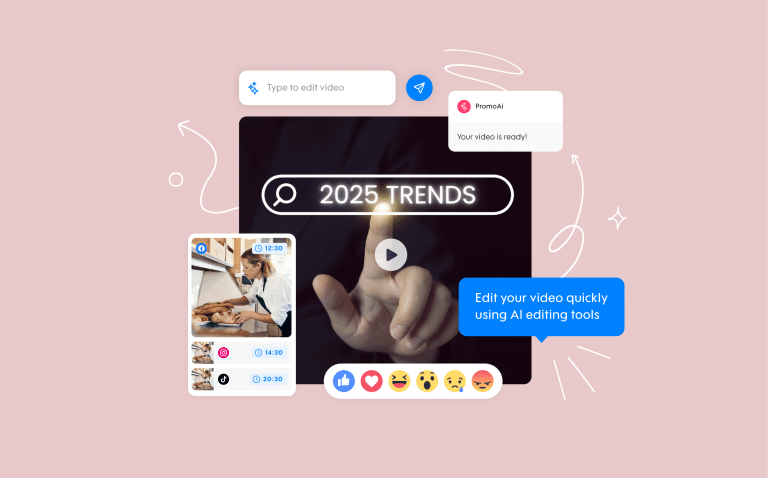
Video Marketing Statistics for Small Businesses
We’ve all heard the “pivot to video” conversation so many times, you’d think most businesses would be spending more time and resources on video by now. But if you’re more of a numbers person, the video marketing statistics are quite compelling.
Entrepreneurs and SMB’s can’t afford to just try different marketing tactics until one gets traction—you need to ensure that your marketing strategy is able to deliver your message in a manner that suits consumers’ needs and preferences. Marketing theories are great for some situations, but in the competitive SMB landscape, digital marketers and small business owners need proof that video can drive business results.
To that end, we’ve gathered the figures that small business owners need to know about video marketing. In this post we’ll cover:
- The consumer preference for video in marketing and sales.
- The broader figures about video consumption to give you a larger perspective.
- The future of video as a medium for traffic.
- The shocking stats around the effectiveness of using video for business.
Each category of video stats is supplemented by a strategic insight to help you get the most out of your online video marketing efforts, along with some additional resources to help you apply the right tactics for you.
Video marketing stats by the numbers—let’s go!
Why use a video maker in your marketing?
Some say that producing a video is difficult (at Promo.com, we heartily disagree!) and that it requires time, creativity, and investment that businesses just don’t have. So why do businesses need to use video in their marketing plan?
Simply put, because it’s what your potential customers want! If the majority of your target audience wanted your product to come in a different color, you’d consider adding it to your product line, wouldn’t you?
Check out the usage and consumption statistics for video:
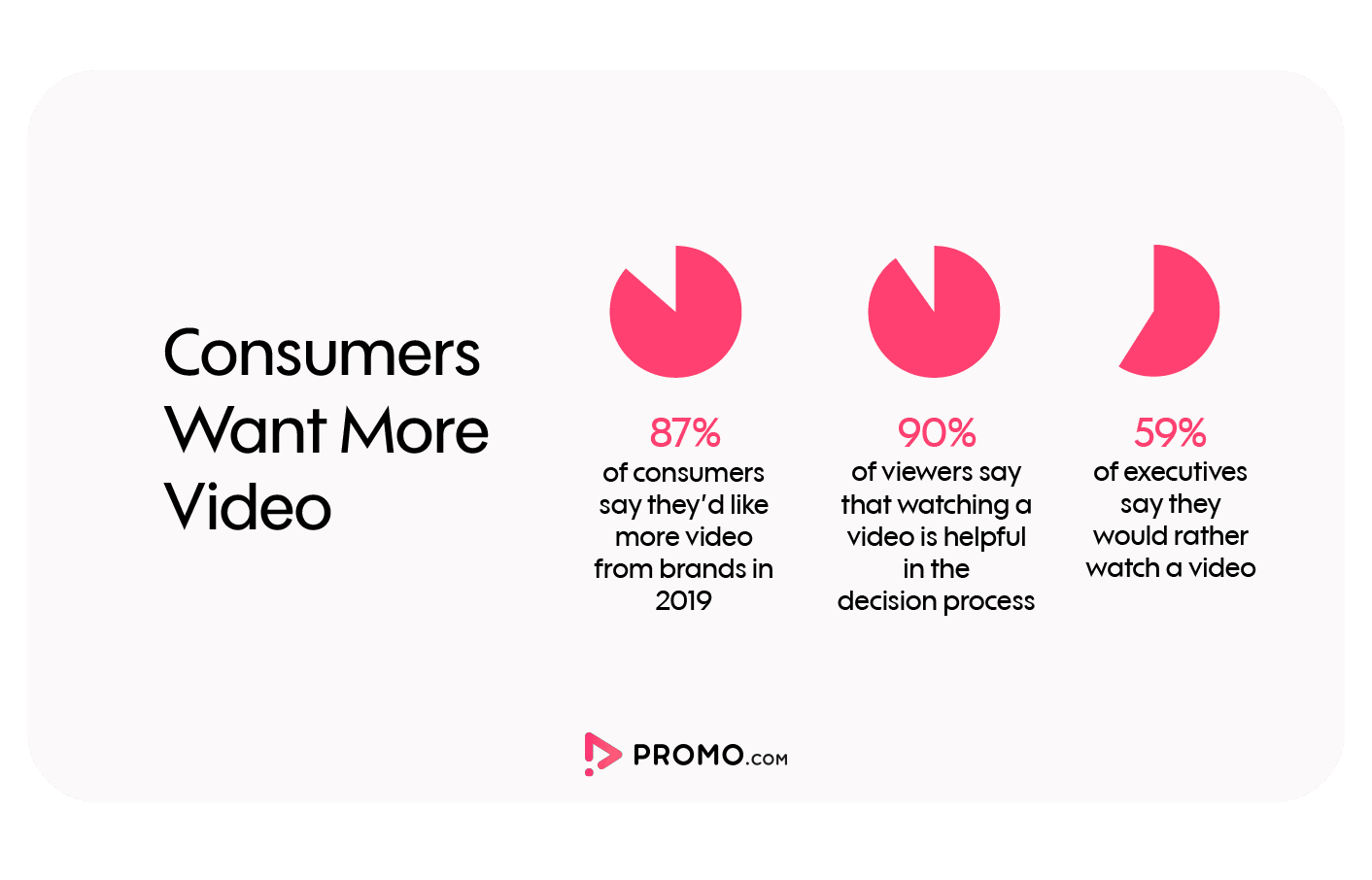
- 87% of consumers say they’d like to see more video from brands in 2019. (Wyzowl)
- 90% of viewers say that watching a video is helpful in the decision process. (HubSpot)
- Viewers retain 95% of a message when they watch it in a video, compared to 10% when reading it in text. (Insivia)
- 59% of executives say they would rather watch a video than read text. (Wordstream)
- 99% of marketers already using video will continue in the year ahead – with 88% planning to increase spend. (Wyzowl)
- 87% of online marketers use video content. (Outbrain)
- Using video on landing pages can increase conversion by 80% (Eyeview Digital)
- Video in an email leads to 200-300% increase in click-through rates (Hubspot)
Key takeaways
When you take a look at the numbers there is a clear consumer appetite for video. Not only are consumers using video to help them make purchase decisions, but they are also actively requesting that more brands provide video content. And the best part is that they’re actually receiving the message in each video, as proven by the retention stats. This is a rare ‘triple win’ in marketing.
Also note the application in B2B scenarios, with executives showing a clear preference for video over text-based content. Product demonstrations, sales pitches, and even delivering insights from data-backed reports—there are tons of opportunities to use video in B2B settings.
As if the consumer thirst for video content wasn’t enough, note that your competitors are likely testing the waters on marketing videos. Or, if they’re already investing in video production, they’re likely to increase their spending in 2020. Another way to put this is that video marketing has virtually 100% repeat customers who are going to invest even more on their next purchase, which is a healthy indication of their confidence.
Next steps
We’re not here to tell anyone how to run their business or force fun, but if you’re looking to get started with video today, here are some great free resources to help grow your business with video:
- Video Marketing 101
- The 27 Best Video Marketing Tools for 2019
- Small Business Marketing Budget: A Visual Guide to Planning Your Promotion Dollars [INFOGRAPHIC]
How much video is consumed online?
The other thing you need to take into consideration when evaluating video for your business is the sheer amount of time people spend consuming video and the frequency with which they watch. Once a behavior has gone mainstream, people start to have expectations for brands to support that type of behavior, and if you don’t, you risk putting them off.
Consider the social media marketing phenomenon—in 2007, Facebook launched its Pages, which allowed brands and businesses to have a presence on its platform. By 2010, every company—both large and small—had a Facebook Page and was actively seeking Page Likes to drive business.
Watching video in nearly all situations (business, personal, education, etc.) is now completely mainstream, and we can prove it:
- 78% of people watch online videos every week, and 55% view online videos every day. (HubSpot)
- Users view more than 1 billion hours of video each day on YouTube. (YouTube)
- On daily basis, people spend around 100 million hours watching Facebook videos (Filmora)
Mobile video consumption rises by 100% every year. (Insivia)
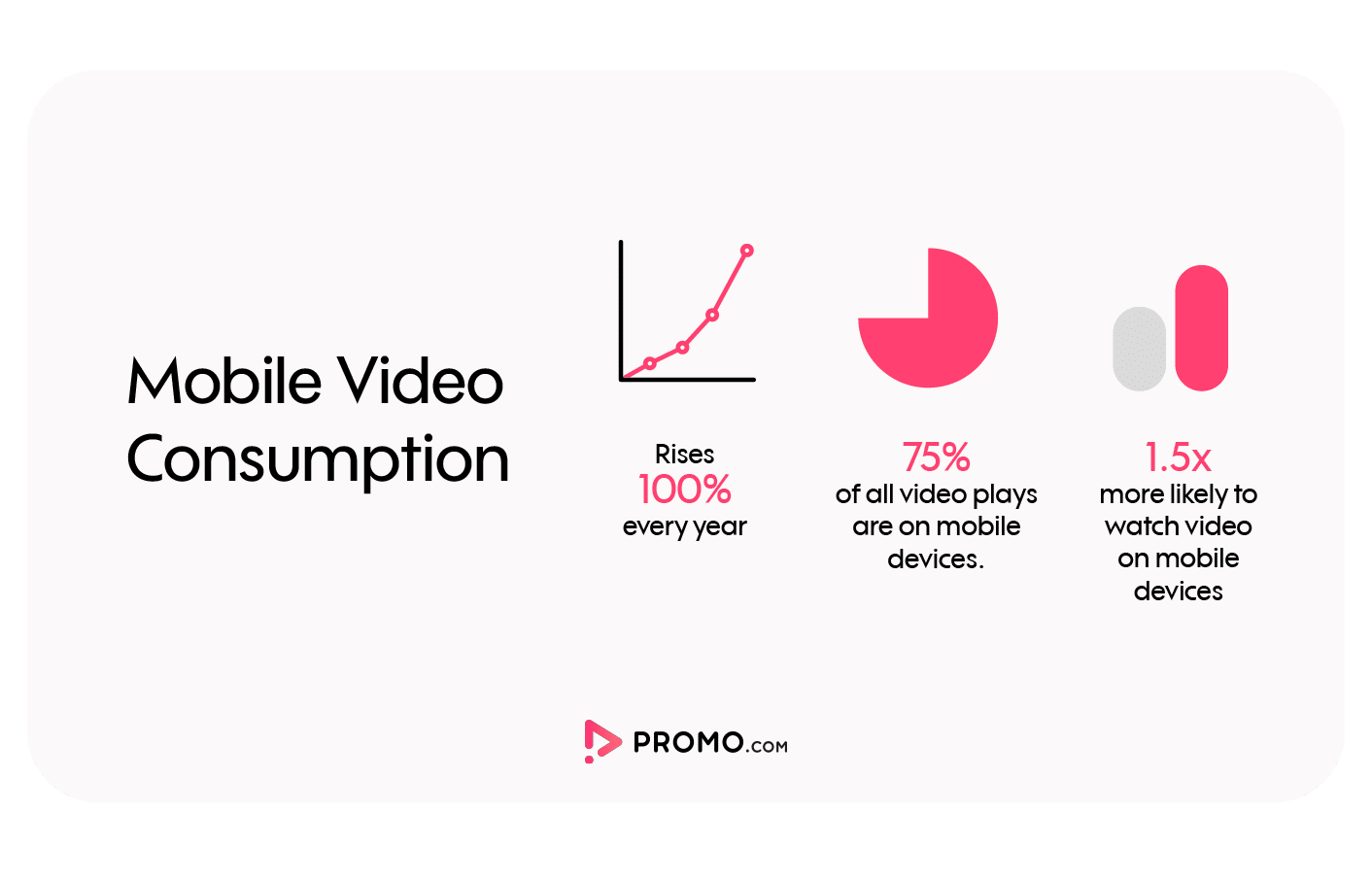
- 55% of people listed video as the type of content they pay close attention to (HubSpot)
- 75% of all video plays are on mobile devices. (eMarketer)
- More video content is uploaded in 30 days than the major U.S. television networks have created in 30 years. (Invisia)
- 45% of survey respondents watch an hour or more of video content on Facebook and YouTube a week (HubSpot)
- People are 1.5x more likely to watch video on their mobile devices. (Facebook)
Key takeaways
People are watching more online and social videos than ever before, and the trend is growing. YouTube and Facebook dominate our screen time, but the breadth of content they cover is seemingly endless. Clever business owners and digital marketers are finding new and exciting ways to cover the topics that their target audiences want to learn more about. From entertainment to B2B to B2C, there is something for everyone on just about any platform you look.
Additionally, the statistics can barely keep up with mobile video consumption. The rapid growth of mobile video matches the increased capabilities of smartphones for both entertainment and business purposes. If you want to have mass appeal, you’ll need to be able to deliver rich video experiences on mobile screens.
Next steps
Wondering how your business might fit into the larger video landscape? Start here:
- 6 Types Of Videos Every Business Can Use
- Social Video Marketing for Any Budget: A Guide to Costs, Options, & Process
- How Much Does it Cost to Make a Promo Video?
What percentage of Internet traffic is video?
As is to be expected with technology, the internet is changing in new (and perhaps unexpected) ways. The amount of internet traffic has grown exponentially in the last decade, with mobile traffic fueling that growth. Now what we’re seeing is that a huge chunk of that traffic is being driven by video, and there’s no sign of that slowing down.
In fact, the numbers show the opposite—video will be the dominant form of web traffic soon!
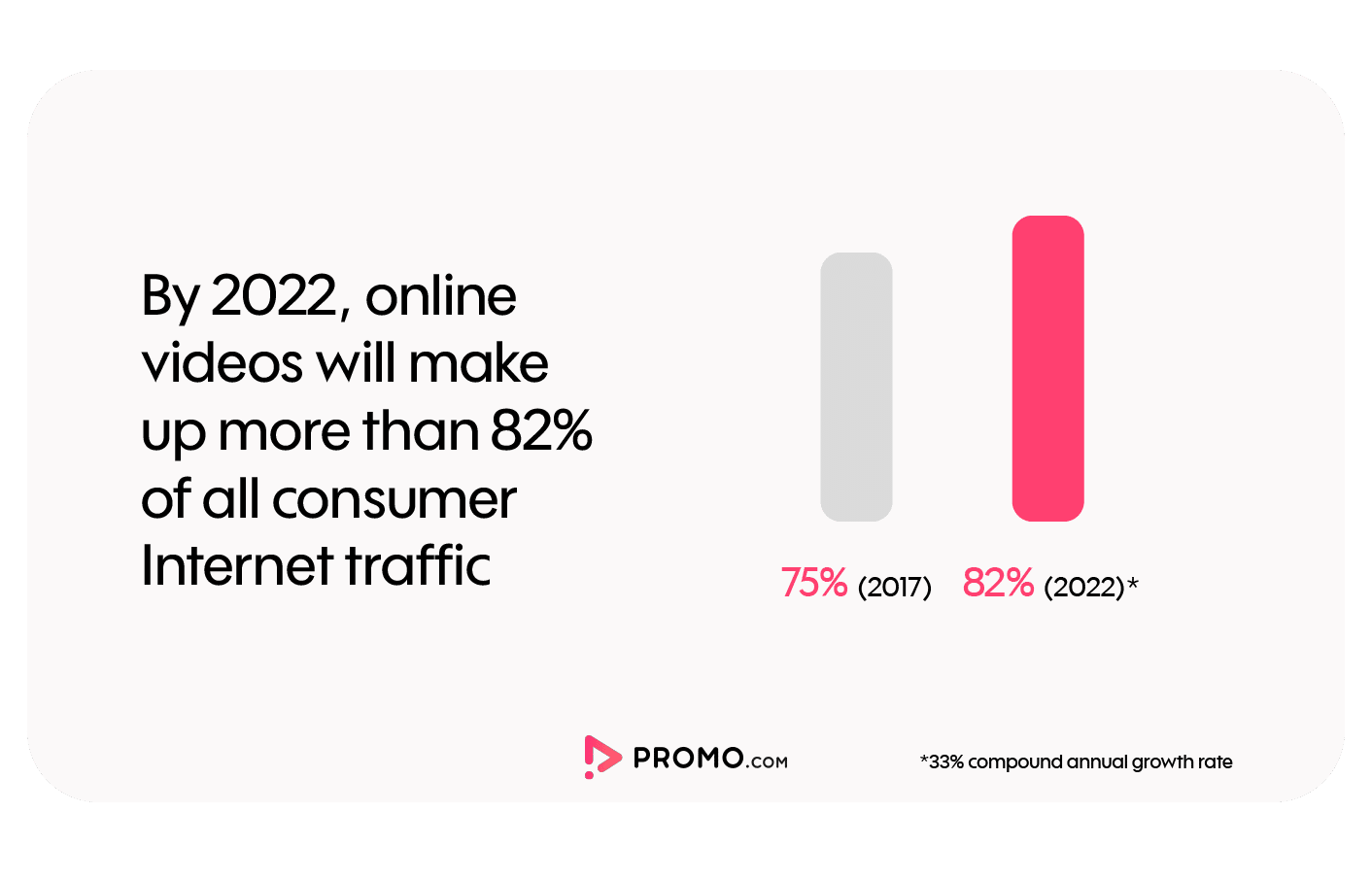
- By 2022, online videos will make up more than 82% of all consumer Internet traffic—15x higher than it was in 2017. (Cisco)
- Users view more than 1 billion hours of video each day on YouTube. (YouTube)
- 6 out of 10 people would rather watch online videos than television. (Google)
- By 2020, there will be almost 1 million minutes of video per second distributed across the Internet.
- Facebook sees 8 billion average daily video views from 500 million users (TechCrunch)
- Live Internet video will account for 17 percent of Internet video traffic by 2022. (Cisco)
Key takeaways
There is an absurd amount of video being watched online right now, and it’s only going to grow! In under 3 years, the vast majority of our online activity will be video-centric. Yes, that includes movie and TV streaming services such as Netflix, Hulu, and YouTube TV, but we will also see increases in video ads, webinars, product tutorials, and so many more business applications.
YouTube has a dominant lead in video screen time, but don’t count out social media platforms like Facebook and Instagram cutting into its market share. As noted, live video traffic is expected to grow significantly, and it would be wise to look into ways to apply live broadcasting to your business now so you can ride the wave.
Next steps
YouTube, Facebook, Instagram, and more social networks all need to be fed video to engage your audiences? If you feel lost about how to even get started, here are some great topics you might want to look into:
- How to Create Your First YouTube Ad
- How People Watch Online Ads According To Facebook
- How to Make Instagram Promo Videos
- What You Need To Know When Getting Started With Instagram TV
How effective are video ads?
As we’ve already mentioned, video is swallowing the Internet and will soon be the dominant form of content. But this isn’t just limited to the core content on streaming services, social media networks, and websites—video will also outwork the more traditional image-based digital ads that drive traffic to those services.
The reason for this, of course, is the proven effectiveness of videos combined with the public’s demand for video content at all levels. Not convinced? Take a look at the statistics on video marketing and advertising:
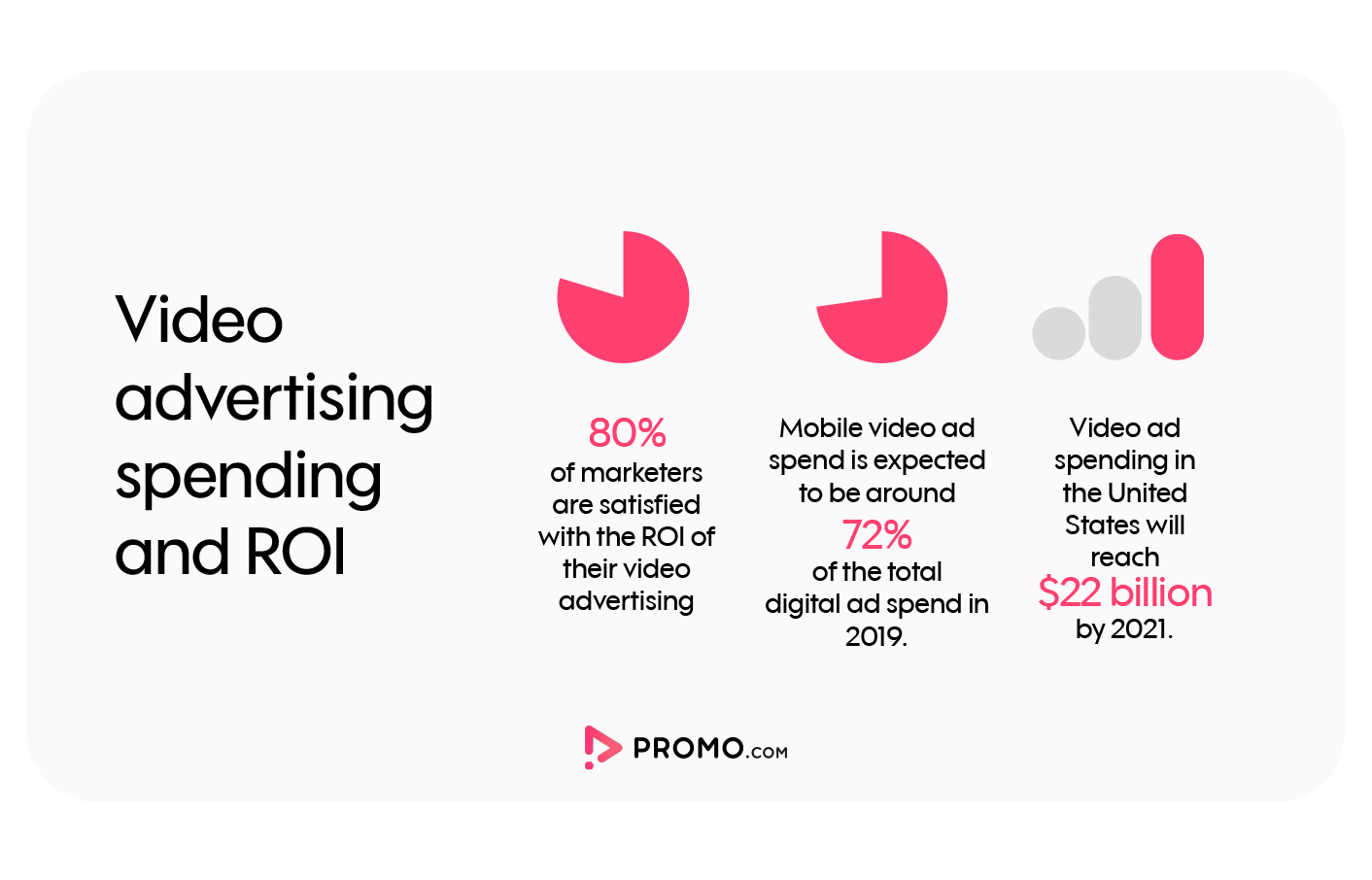
- 80% of marketers are satisfied with the ROI of their video advertising (Animoto)
- Facebook video ads receive 10-30% more views than other ad formats. (Solocube)
- 80% of users recall a video ad they viewed in the past 30 days. (Small Business Trends)
- Mobile video ad spend is expected to be around 72% of the total digital ad spend in 2019. (eMarketer)
- Video ad spending in the United States will reach $22 billion by 2021. (Statista)
Key takeaways
Digital marketers are using video advertisements in diverse ways, from branding and awareness to conversion and direct response, but they all have one thing in common—they’re working. Higher view rates and increased consumer recall both indicate that videos are a highly effective medium for digital advertising.
And the effectiveness of video advertising extends into mobile placements as well, which is a healthy sign given the continued rise of video consumption via mobile devices.
Next steps
Whether you’re looking to create video ads, learn more about the differences between static image ads, choose a platform to run your ads on, or find out how to increase your conversion rates with video ads, we have you covered. Check out a few of these resources specifically designed to help you maximize your success with online video ads.
- Video Ads vs Image Ads: A Comparison
- How to Measure the Effectiveness of Your Video Ads
- Facebook vs YouTube Ads: Best Bang for Your Buck?
So there you have it; video marketing statistics updated for 2019. We hope you find the figures useful, but more importantly, we hope you use them to do something.
Andrew Lang, the 20th century Scottish poet, said it best:
“I shall try not to use statistics as a drunken man uses lamp posts; for support rather than for illumination.”
We know that you have a lot to say, and by now you know that your audience also wants to hear it—in the form of video. So let’s give them what they want. It’s time to invest your time and resources into video production, but it’s not nearly as expensive or time-consuming as you might think.
Promo.com is a creative platform that allows you to easily, simply, and affordably create marketing videos for virtually every business need—from digital ads to landing pages to social videos. The investment in your video marketing strategy now can bring loyal customers for years to come.



